Acknowledgements
Dr. Amalia Nivón Bolán is a tenured professor at Mexico City’s National University of Education Sciences (UPN) and at the time of this writing was the director of its Student Support Center (CAE). In that role she was key to motivating blind and visually impaired students. E-mail: anivon@upn.mx.
A thank you to Nevin Siders, tenured professor at UPN, for translating the text into English.
A Tool for the Blind to Learn English
Óscar Fernando Velasco Romero, Mexico
Óscar Velasco is a tenured professor at Mexico City’s National University of Education Sciences (UPN) and is a counselor in its Student Support Center (CAE). He has been an English teacher for nearly three decades. E-mail: ovelasco@upn.mx
“You’ve done something big,” Nevin said…
and I’ll never forget that morning.
Óscar
Menu
Abstract
Aims
Background and literature review
Methodology
Specifications of the adaptive accessory
Progress
Conclusions
Future
Bibliography
While learning tools for sighted students have always included a hands-on component, the need persists for such devices for blind and visually impaired students when learning English. In a pilot stage, the teacher detected the students’ cognitive styles which led to creating an adaptive accessory that permits manual and mental movement. The manipulative device incorporates touch, listening comprehension, reading in Braille, and sequential and ordinal experiences that facilitate oral interaction in the English language in situations and pragmatic aspects compatible with their condition.
keywords: blind, foreign language, adaptive accessory, order and sequence, touch, audition, pragmatics, haptics, syntax, kinesthetic
To meet a need to make the English language accessible to blind and visually impaired students by using an adaptive accessory, described by Cebrian-De-Miguel (2005) as an “apparatus or utensil especially adapted for use by persons who are blind and visually impaired.”
To make compensatory learning resources available for this population, so as to begin to fill a gap in teaching resources and materials.
To open a discussion on teaching options that may coordinate learning themes and contents adapted for the blind, and the epistemological dimension which provides the blind a possibility to become actively involved in the management of their own cognitive activities and processes so as to create messages and meanings compatible with their condition.
During Mr. Velasco’s three decades of professional practice among sighted adults, his didactic innovations were sufficient to meet the needs of that population. However, as the pilot stage of this project was launched in the autumn of 2008 to identify the cognitive styles of the blind, the teacher’s limitations became evident when presenting the English language to blind students under their linguistic skills, for he had but norms and expectations centered on their sighted counterparts’ experiences, which were unsuitable to this new population.
The course designs that may be derived from the adaptive accessory for the blind adult mesh with the hypotheses formulated by Fernández et al. of the Universidad Autónoma de Madrid. (1988: 74, 75) These authors propose that the “learning obtained from broadening tasks is proportional to the type of ordering or sequencing code used” between English and Spanish, predicting qualitatively superior results given the differences negotiated between the tactile and oral modes.
Another issue is the compatibility of cognitive information processing with conscious transformation mediated by the various types of memory the blind learner possesses. Franklin (2005) describes a multiplicity of conceptualizations in circulation about the types of memory: sensory, procedural, operative, declarative, episodic, semantic, long and short term, among others.
In the specific case of the visually impaired, work with the short term memory is preferable due to its acoustic importance and, thus, the connection and decodification which the blind learner is capable of realizing through it. Similarly, Viramonte de Ávalos (2004: 32, 33, 34) speaks of an operational memory, theorizing that the student has an acoustic experience in the long-term memory which, when activated, incorporates exterior information via operational memory.
Markovitch (1983) postulates that lexical ambiguities are processed by analyzing larger contexts which aids in accessing a single meaning. In that way, the resolution of ambiguity in situations charged with multiple meanings becomes feasible when an activity included operates by choosing one option from a list.
Based on these considerations, an adaptive accessory was created with 15 pegs to prepare input (Krashen, 1985) by aiding the learner to express and recognize the immediate constituents in an utterance. A contextual opening is necessary for a personal pronoun (I, you, he, she, it, we, you, they), because it is understood that an example is structured in response to learning and linguistic needs.
The circumstances led to action research to provide attention to a team of blind and visually impaired students. The English teacher organized the course so that the students collectively and individually presented their needs to adapt sound materials and adjust situational dialogues that would permit the learners to hear and speak, and so that the teacher would be able to construct an environment in which oral assimilation would not restrict the medium of interaction in the first hours of study.
In response to the desire to teach English through brief, contextualized repertories, but which lacked means to provide feedback or to provide new information and utilize that which derived from the student-teacher interaction, learning and reading materials were provided in Braille and enlarged text in black print. Despite these alternatives, the students continued to perform in the “banking” manner described by Freire (1993) where student participation that would foster linguistic competence was still lacking. Although some were more extroverted, unfriendliness from some others reflected saturation.
At the same time, it was noted an extensive use of cassette and iPod recorders, preventing blind students from making changes and/or combinations of their own. A new sequence for participation was proposed based on the knowledge that the blind not only have a highly developed sense of touch and audition, but also their perception of order and sequence is present in nearly all of their routines. Group dynamics were designed so that the students would take turns to bodily represent each segment of an utterance. By being rotated in their positions until they introduced the collocation and meaning of the subject, verb, complement, etc., communicative situations were introduced in line with their experiences and the corresponding substitutions. They then moved to the parts of the utterances that each personified or represented.
This dynamic turned out to be partially and temporally constructive, and became fertile ground for further ideas until it grew into the device described in the next section that is didactic, practical, flexible, accessible, economical, and useful.
The need to have an instrument with which blind learners can explore and categorize the constituents of an English sentence, and with which the teacher and students may make verbal substitutions, prompted the creation of this learning tool as a sensory auxiliary compatible with the abilities of these learners.
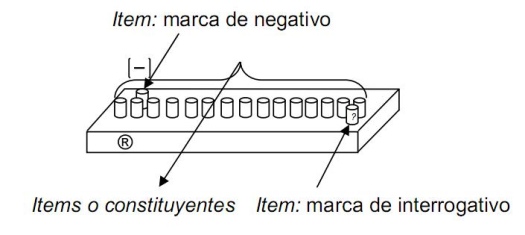
Figure 1: Schematic diagram of the adaptive accessory for the blind and visually impaired (®2011)

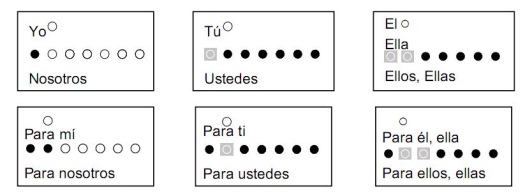
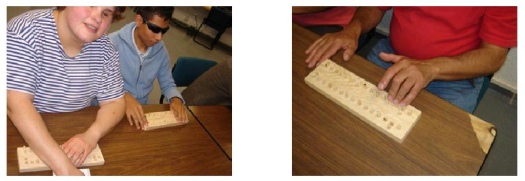



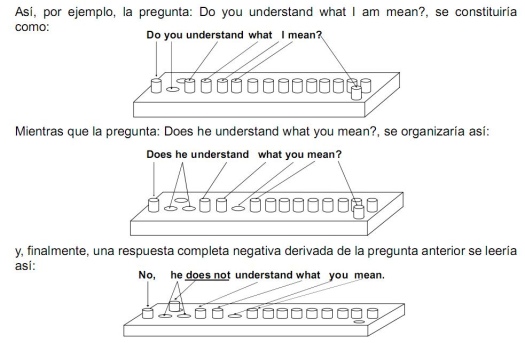
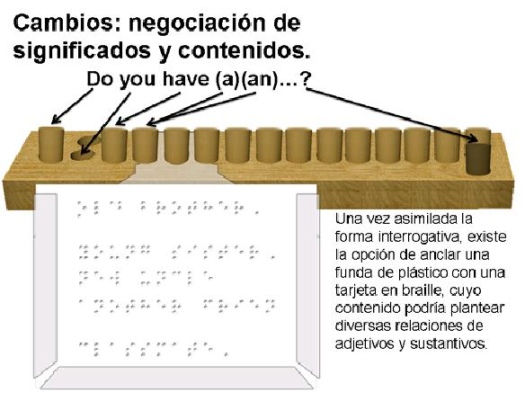
Figure 9: Once the interrogative form is understood, there is an option of anchoring a plastic sleeve with a Braille card, whose content could be, for example, various relations of adjectives and nouns.
Participants in the activity can manipulate the rods to agree and to negotiate meaning by using the 17 rods to exemplify not only single words but also whole phrases and sentences. This works because 15 of the spaces are laid out in a line, serving as constituents in the construction/expression of declarative sentences. In consonance with the convention of left-to-right reading and writing in English, a 16th hole is located directly above the second position in the main line, and filling that space with a peg signifies a negation. The first and second pegs might also represent a subject or its pronoun, main, or auxiliary verb. Placing a peg in the final space located below the line formulates questions.
Thus the distribution of the constituents is motivated by the lexical conventions of the English language, as does the presence or absence of the negative and interrogative extensions to the upper left and lower right. The various words and phrases may be negotiated as simple, compound, and complex combinations.
The initial conception of this device was a practical application that would facilitate tactile and auditory perception with oral articulation. Yet its potential and flexibility for adjusting linguistic and grammatical conventions permit achievement of communicative competence in English beyond the confines of the classroom.
In the search to meet the extent and density of utterances with the number of items that the blind handle in their procedural memory which are meaningful in their foreign language learning context, the number of 15 slots was agreed upon per the nine to 12 items or concepts that the procedural memory is able to identify and manipulate manually and mentally.
The long term memory then assigns or interprets semantic and episodic meaning negotiated with some of the items, to be recreated at a later time, within the parameters of diversity and individual learning styles observable in working memory.
In general, the order or sequence the blind transfer from input to objects — the immediate constituents in this case — determines their construction and mental representation of the parts of the several situational foreign language dialogues used as teaching tools and mediators of linguistic interaction.
Concerning motivation and conventions, this device facilitates approach to a second language in both its instrumental and integrative dimensions, because the learner achieves strategic application to recognize grammatical and syntactic change by substituting, segmenting, selecting, combining, and transforming the constituents, strengthening this skill by increasing lexicon, knowledge of the L2, gradually becoming able to collaborate and socially exchange information.
In its morpho-syntactic and pragmatic dimension, the device mediates interpretation and comprehension by aiding to position the constituents; it thereby supports decoding and constructing of diverse concepts, significations, and objects. Teaching tasks may be translated into organizing blind learner’s internal and external experiences. Their touch, hearing, and kinesthetic perceptions require sensory inductive-deductive channeling set to the rhythms and manners in which this population processes information, structuring their semantic knowledge to form, distinguish, and represent figures of the outside world.
In the device’s movements or manipulative applications, participants have shown an improved attitude toward incorporating their knowledge and interpreting situational dialogues so as to accommodate the constituents according to verb tense and mode. They also perform processes in which they transform their information into language and actions they themselves generate.
With such actions the participants create strategies that greatly increase their learning while making it possible to decode incomplete utterances; the participants provide the lexical items to complete the predicate, which gives evidence of the cognitive and metacognitive growth the device facilitates. This ability to monitor constituent order and sequence is a manifestation of development in L2 linguistic and interactive competence achieved among the blind.
In sum, the interaction achieved to date highlights the schemata blind students construct with their knowledge, and the potential for syntactic building of new constituents presented via the mediation of this instrument.
The university’s Student Support Center (CAE) intends to continue participant research in the use of this device among its own students of educational psychology and pedagogy.
It is not limited to learning foreign languages; investigation into native tongue literacy will also be promoted. It is possible to project use of this inexpensive, flexible learning tool in specialized schools for the blind at many levels of schooling, in the public and private health sectors, hospitals, workplaces, and home by civil societies and teacher colleges.
Cebrian-De-Miguel, María Dolores. 2005. “Glosario de Tecnologías de la Información Comunicación”, in Entre dos mundos, Revista de traducción sobre discapacidad visual, número 27, p. 51. retrieved June 10, 2009 from
www.once.es/appdocumentos/once/prod/SS-PUB-EDM-27.pdf
Fernández, E. et al. 1988. “Memoria a corto plazo y modalidad sensorial en sujetos ciegos y videntes: efectos de la similitud auditiva y táctil”, in Universia.net, número 41, pp. 74, 75. retrieved June 29, 2009 from
biblioteca.universia.net/ficha.do?id=44807767
Freire, Paulo. 1993. Pedagogy of the Oppressed. New York: Continuum Books. retrieved July 23, 2011 from
www.webster.edu/~corbetre/philosophy/education/freire/freire-2.html
Krashen, S. 1985. The Input Hypothesis: Issues and Implications. London: Longman
Markovitch, J.S. 1983. Effects of context on the processing of lexical ambiguities. p. 3. in Cogprints, Cognitive Science Eprint Archive. retrieved July 16, 2009 from
cogprints.org/view/subjects/percep-cog-psy.html
Stan, F. et al. 2007. The Role of Consciousness in Memory. www.brains-minds-media.org, p. 2. retrieved July 16, 2009 from cogprints.org/5806/1/wrcm-bmm.pdf
Velasco Romero, Óscar F. 2009. Dispositivo didáctico para la enseñanza del inglés a ciegos y débiles visuales. Mexico City.
Viramontes de Ávalos, M. 2004. Comprensión lectora: Dificultades estratégicas en resolución de preguntas inferenciales. Buenos Aires: COLIHUE.

Please check the Special Needs and Inclusive Learning course at Pilgrims website.


|